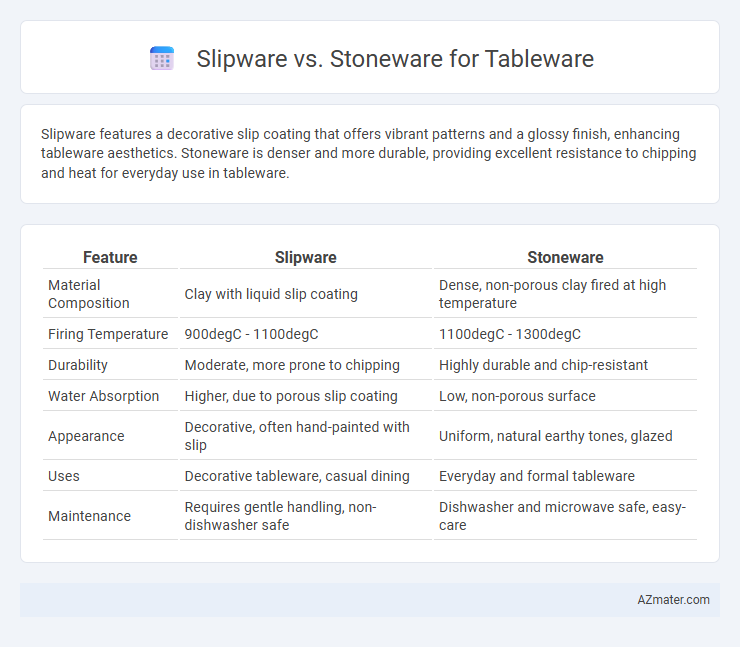Slipware features a decorative slip coating that offers vibrant patterns and a glossy finish, enhancing tableware aesthetics. Stoneware is denser and more durable, providing excellent resistance to chipping and heat for everyday use in tableware.
Table of Comparison
| Feature | Slipware | Stoneware |
|---|---|---|
| Material Composition | Clay with liquid slip coating | Dense, non-porous clay fired at high temperature |
| Firing Temperature | 900degC - 1100degC | 1100degC - 1300degC |
| Durability | Moderate, more prone to chipping | Highly durable and chip-resistant |
| Water Absorption | Higher, due to porous slip coating | Low, non-porous surface |
| Appearance | Decorative, often hand-painted with slip | Uniform, natural earthy tones, glazed |
| Uses | Decorative tableware, casual dining | Everyday and formal tableware |
| Maintenance | Requires gentle handling, non-dishwasher safe | Dishwasher and microwave safe, easy-care |
Introduction to Slipware and Stoneware
Slipware is a type of pottery characterized by the use of liquid clay slip applied to the surface for decorative effects, often resulting in intricate patterns and a smooth finish. Stoneware is a durable, dense type of ceramic fired at high temperatures, renowned for its strength and resistance to chipping, making it ideal for everyday tableware. Both materials offer distinct aesthetic and functional qualities, with slipware emphasizing artistic surface treatment and stoneware providing robust utility.
Historical Background of Slipware
Slipware, originating in ancient pottery traditions, uses liquid clay slip to create decorative and functional tableware, with roots tracing back to Neolithic times and flourishing in medieval England and China. This technique allows intricate patterns and textures, distinguishing it from stoneware, which is fired at higher temperatures for durability and a non-porous finish. Historically, slipware represents an artistic evolution in ceramics, combining utility with elaborate aesthetic appeal in everyday dining objects.
Origins and Evolution of Stoneware
Stoneware originated in ancient China during the Shang Dynasty (1600-1046 BCE) and evolved through centuries as a durable, vitrified ceramic known for its strength and non-porous surface, making it ideal for tableware. Unlike slipware, which is characterized by decorative slip coatings applied to earthenware and developed in medieval Europe, stoneware's robustness comes from high-fired clays that mature at temperatures between 1,200 and 1,300 degrees Celsius. Over time, stoneware's functional advantages and adaptability led to widespread use across Asia, Europe, and America, influencing contemporary tableware designs with its practical resilience and aesthetic appeal.
Material Composition: Slipware vs Stoneware
Slipware is crafted by applying a liquid clay slip coating over a base clay body, often earthenware or stoneware, creating decorative surfaces with contrasting colors and textures. Stoneware is made from vitrified clay fired at higher temperatures, resulting in a dense, non-porous, and durable material ideal for functional tableware. The material composition of slipware emphasizes artistic surface treatment, while stoneware focuses on strength and utility through its inherent clay properties.
Manufacturing Processes Compared
Slipware is created by applying liquid clay (slip) onto a pottery base, allowing for intricate surface decoration and a lighter, more porous finish that requires glazing for durability. Stoneware is made from a dense, naturally vitrified clay, fired at higher temperatures (around 1200-1300degC), resulting in a robust, non-porous body with higher strength and resistance suitable for everyday tableware. The key manufacturing difference lies in slipware's decorative layering and lower firing temperature versus stoneware's solid, high-temperature firing that produces a more durable and chip-resistant product.
Aesthetic Differences and Design Versatility
Slipware features vibrant, hand-painted designs with fluid, artistic patterns created by applying slip clay, offering a unique, rustic aesthetic ideal for eclectic or bohemian table settings. Stoneware presents a more uniform, durable surface with subtle earth tones and minimalist textures, providing a versatile foundation for modern and classic designs. The tactile contrast and color depth make slipware bold and expressive, while stoneware's refined finish ensures functional elegance suited to everyday use.
Durability and Practicality for Tableware Use
Stoneware offers superior durability due to its dense, non-porous composition fired at high temperatures, making it resistant to chipping and suitable for everyday tableware use. Slipware, characterized by decorative slip coatings over earthenware, tends to be less durable and more prone to wear and chipping under frequent use. Stoneware's practicality also includes better heat retention and dishwasher safety, positioning it as the preferred choice for functional, long-lasting tableware.
Safety and Food Compatibility
Slipware, coated with a liquid clay slip, offers an artisanal aesthetic but requires careful glazing to ensure food safety and prevent leaching of harmful substances. Stoneware is denser and fired at higher temperatures, making it non-porous, durable, and highly resistant to bacteria absorption, ensuring superior food compatibility and safety for everyday use. Both materials must meet FDA standards, but stoneware's vitrified surface typically provides more consistent protection against chemical contamination.
Cost and Accessibility of Slipware and Stoneware
Slipware tableware is generally more affordable due to its traditional hand-applied slip decoration techniques that require less advanced firing processes, making it accessible for budget-conscious consumers. Stoneware, known for its durability and non-porous surface, tends to be pricier because of higher firing temperatures and more complex manufacturing methods. The widespread availability of stoneware in retail outlets contrasts with slipware's niche market presence, often found in artisanal shops or specialty ceramics stores.
Choosing the Right Tableware: Slipware or Stoneware?
Slipware offers a unique aesthetic with its colorful, hand-decorated designs created by applying liquid clay slips on the surface, making each piece visually distinctive and ideal for artistic table settings. Stoneware provides superior durability and chip resistance due to its dense, vitrified body fired at high temperatures, perfect for everyday use and dishwasher safety. When choosing the right tableware, consider slipware for decorative appeal and casual entertaining, while stoneware ensures long-lasting functionality and versatility for regular meals.

Infographic: Slipware vs Stoneware for Tableware
 azmater.com
azmater.com